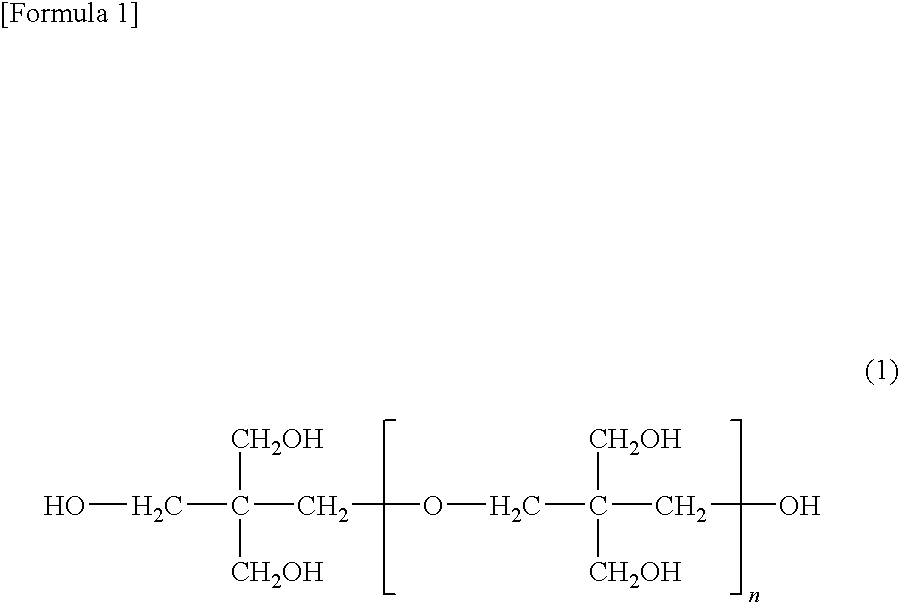Stabilizer for chlorine-containing resins and chlorine-containing resin composition
- Summary
- Abstract
- Description
- Claims
- Application Information
AI Technical Summary
Benefits of technology
Problems solved by technology
Method used
Image
Examples
examples
[0123]The structure and effects of the present invention will be described in further detail below through Examples thereof. The present invention, however, is not limited whatsoever to the Examples described below.
examples 1-1 to 1-3
and Comparative Examples 1-1 to 1-3
[0124]The following evaluation was made for the polyol mixtures (stabilizers for chlorine-containing resins) shown in Table 1 below. Note that quantitative compositional analysis of the polyol mixtures was made according to the following procedures using area ratio in gas chromatography.
[0125]Compositional Analysis:
[0126]Each solution made by adding 2 mg of one of the samples to 0.5 ml of a sililation reagent (product of GL Sciences Inc.; “TMSI-H”) was raised in temperature to 80° C. and retained for 15 minutes. After confirming that the solution became transparent, the solution was left to cool to room temperature, and quantitative analysis was made according to the following conditions using area ratio through gas chromatography. The results are shown in Table 1.
[0127]Indicating the degree of condensation of pentaerythritol as “n”, the retention time for each component in the polyol mixture was n=1 (0.9 min), n=2 (4.5 min), n=3 (7.3 min), and n=4...
examples 2-1 to 2-3
and Comparative Examples 2-1 to 2-5
[0133]Using a rocking mill, 1.0 parts by mass of zinc stearate, 0.5 parts by mass of calcium stearate, 0.5 parts by mass of hydrotalcite (product of Kyowa Chemical Industry Co., Ltd.; “ALCAMIZER 1”), 0.2 parts by mass of dibenzoylmethane, 0.2 parts by mass of tetrakis[methylene-3-(3,5-di-tert-butyl-4-hydroxyphenyl)propionate]methane, 1.5 parts by mass of an acrylic polymer processing aid (product of Mitsubishi Rayon Co., Ltd.; “P-551A”), 0.5 parts by mass of a slip additive (phthalic distearate), 0.4 parts by mass of titanium oxide, and 0.5 parts by mass of one of the polyol mixtures shown in Table 1 were mixed to 100 parts by mass of vinyl chloride resin (degree of polymerization: 700), to obtain respective chlorine-containing resin compositions (vinyl chloride resin compositions).
[0134]Note that the polyol mixtures shown in Table 1 that were used passed a 60-mesh sieve (mesh size: 250 nm). The following evaluations were made for each of the chlor...
PUM
| Property | Measurement | Unit |
|---|---|---|
| Percent by mass | aaaaa | aaaaa |
| Percent by mass | aaaaa | aaaaa |
| Percent by mass | aaaaa | aaaaa |
Abstract
Description
Claims
Application Information
 Login to View More
Login to View More - R&D
- Intellectual Property
- Life Sciences
- Materials
- Tech Scout
- Unparalleled Data Quality
- Higher Quality Content
- 60% Fewer Hallucinations
Browse by: Latest US Patents, China's latest patents, Technical Efficacy Thesaurus, Application Domain, Technology Topic, Popular Technical Reports.
© 2025 PatSnap. All rights reserved.Legal|Privacy policy|Modern Slavery Act Transparency Statement|Sitemap|About US| Contact US: help@patsnap.com

